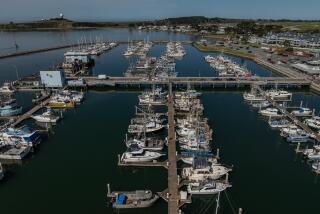Getting a Line on America’s Growing Appetite for High-Quality Fish : Distribution Network Keeps Catch Moving From Sea to Your Table
GLOUCESTER, Mass. — Health-conscious Americans have turned to fish. While consumption still trails far behind chicken and beef, in 1987 Americans ate a record amount of seafood--15.4 pounds per capita.
At the same time, the cost of fish escalated more than that of any other protein food. This demand has not only put a strain on consumers’ pocketbooks, but also on the system’s ability to provide fish of consistently high quality.
Transporting all this fish from the sea to the plate is a massive and difficult task, a race against the clock that must maximize shelf life and minimize temperature abuse. For example, if a cod fillet is stored at 32 degrees, its shelf life will be 14 days, according to the National Marine Fisheries Service. Seven degrees warmer and that cod’s shelf life will be cut in half.
From the water, a fish may go through five owners before it is purchased by a consumer. Because of their sales volume, supermarket chains can buy directly from processors who will ship fish to the chains’ main distribution centers. From there, the products are shipped to individual stores.
Convolutions, Exceptions
Specialty fish shops and restaurants usually buy from a wholesaler. But there are many convolutions and exceptions. Often, wholesalers sell to one another.
To consolidate orders, processors often ship fish back and forth with no apparent geographic logic; turbot and john dory caught overseas are flown into Dulles Airport outside Washington and shipped to Steve Connelly’s seafood plant in Gloucester, where they are repacked and then shipped back to Washington restaurants. Connelly also buys grouper caught in Florida, processes it and then ships it back to Florida restaurants.
“Quiet, boys,” the woman orders in a distinctive Boston accent. It is 6:30 on a Monday morning, and the start of the Boston Fish Auction.
In a musty room with the atmosphere of a disinterested high-school class, a group of about 20 buyers from Boston’s fish-processing plants are gathered to bid on the morning’s catch--a load from about seven boats that have returned from a week out on Georges Bank, one of New England’s prime fishing areas. These processors ship fish all over the country.
Aside from Boston, there are four other fish auctions in the country--New Bedford, Mass.; the Port Authority of New York and New Jersey; Portland, Me.; and Honolulu.
Bought Sight Unseen
In Boston the auction is not a display; processors will purchase fish they have not seen.
A blackboard at the front of the room lists the names of the boats, the type of fish and the amount caught: The Carol Ann, the Captain Sam II, the Nancy & Heidi, the True Life, the Reliable. Haddock, cod, gray sole, hake, cusk, flounder. For example, the Carol Ann is listed for 500 pounds of haddock among its catch; the Captain Sam II, for 500 pounds of gray sole.
The buyers are a hardened lot who know the inner workings of this business like the inside of a timepiece. There are people such as Bobby Brandano, in his shiny black jacket with Great Eastern Seafood emblazoned in gold, his onyx pompadour and his tight-fitting jeans.
Brandano keeps close tabs on what boats have gone out to sea and when they are scheduled to return. Fishermen have reputations, and Brandano wants to buy from the best.
There’s Mike Vitales from Puritan Seafood, who sells to seafood distributors who in turn sell to upscale markets and restaurants. (Today, Foehrkolb will buy 200 pounds of cod, 50 of pollack, 160 of flounder and 120 of gray sole from Vitales.)
“All the haddock is for sale,” the auctioneer begins. The bidding starts at $1.50 a pound, ends at $1.75. There are 3 minutes to bid on each species until the buzzer is rung.
During the auction, several of the buyers talk in muffled voices on telephones lined against the wall, relaying the bids to their companies as they are shouted, inquiring whether they should up the bid depending on their client’s demands. In between, the woman in charge repeats: “Quiet, boys.”
There are a lot of things that are not being said openly here, most of them based on the supply of fish landed elsewhere. By 5 a.m., the buyers were in their offices, calling around to find out the amount of fish landed at other New England ports.
More importantly, the availability and price of fish in Canada also has a crucial impact on the price and quality of fish purchased domestically.
Close to 60% of all the groundfish--the cod, haddock, flounder, etc.--that are eaten in this country are actually landed off Canada, primarily off the coasts of Nova Scotia and Newfoundland. Domestic waters have been largely overfished for these species.
Canadian Fish
This Canadian product is trucked and-or ferried from the Maritimes into the United States and is called “over-the-road fish.” Because the American dollar is worth more than the Canadian, and because the supply of fish is greater, it is less expensive than domestic “dock fish” and can be paid for as much as 30 days later--a great incentive for many processors, according to Connelly.
As a result of the time it takes to get to this country, however, the Canadian fish are “almost never as good quality” as domestic fish, Connelly believes.
Practically all New England processors are forced to buy Canadian fish at one time or another to meet demand, but “as a rule” more of it will go to large supermarket chains, according to Lee Weddig, director of the National Fisheries Institute.
On this particular morning, market-sized cod sell at the Boston auction for 70 cents a pound. Over-the-road cod from Canada are selling for 55 cents a pound, according to one processor.
Because there are a lot of over-the-road fish available this morning, the Boston buyers don’t have to clamor for dock fish, which explains the somewhat sluggish pace of the auction, the processor said.
But this is where defensive games come in: One processor, who asked not to be identified, said that if he knows he will be buying fish from Canada, he may start a bid at the auction even though he has no intention of buying it.
No Secrets
He will open the bid at the price of the Canadian fish, figuring another bidder will up the ante. The upshot, he hopes, will be that a competitor will buy the load and end up paying more (and having to sell for more) than he does. As he explained, “Everybody knows who’s doing what to whom.”
Tom Morris, sales manager of Empire Fish, said that before fishermen go out to sea, they’ll arrange code words with him for when they radio in their catches. The radio waves at sea are open. “Before they leave, they’ll tell us, ‘Every time we say we’re catching pollack, it’ll mean haddock,’ ” said Morris. “Or if they say ‘we’ve caught 150 pounds,’ it really means 1,500. They could talk in Italian, but they’re all Italian.”
After the Boston auction, the fish prices are relayed to Gloucester processors, who set their prices accordingly, generally at 3 cents to 5 cents less per pound because the Gloucester boats are unloaded by workers from the processing plants themselves. The fishermen don’t have to pay “lumpers,” workers who unload fish at the Boston pier.
The pricing structure gets even more complex: Though Empire paid 67 cents a pound for cod on this day, that price has little correlation to what the supermarket will pay the processor. Because supermarkets need to know prices a week or more in advance to plan for ads, Morris must quote a chain a price even before the fish are caught. “You talk about a crap shoot,” he said.
Also, the 67 cents represents what Empire paid for the whole cod, not the fillet. Once the fish is filleted, only about a third of its original weight remains.
Thus, that cod really cost Empire $2.23 a pound. According to the prior arrangement, the processing firm charged Safeway $3 a pound for the cod. The chain then sold it at fish counters for $5.49--an 83% markup.
Ann Cockrell, spokesperson for Safeway, said that the chain “does not discuss gross profits,” but that the markup simply reflects “our costs and the cost of getting it to the consumer.”
Some people pay the Boston auction price, but after that “there are a zillion exceptions,” according to Dave Coombs, manager of Steve Connelly’s Seafood.
For example, if the fish are not of the quality that the processor expected, the price may be renegogiated with the fisherman when they are unloaded.
Or, a processor or distributor who gets stuck with a product that it knows its clients will not accept may sell it to another. “I guarantee that the stuff I reject gets sold to a less discerning restaurateur,” said Bob Kinkead, owner and chef at 21 Federal restaurant in Washington.
In fact, this type of practice may offer one explanation for the varying quality of seafood. For example, on a recent Friday afternoon, a Washington-area distributor left a whole swordfish lying in the warehouse, rejecting it because its bloodline was brown--not red--indicating that it was an older fish. At some point during the beginning of the following week, the fish would be sold to someone else. In the meantime, it would deteriorate further.
Those processors, distributors and wholesalers who are most concerned about quality keep close tabs on the fish all along the distribution chain--starting at the docks.
Following the Boston Fish Auction, for example, several of the processors pick and choose fish after they are hoisted in canvas bags from boats in the harbor. Steve Connelly’s Seafood also makes sure that its buyer is in close proximity while this is occurring.
“Romeo goes to their weddings, their funerals,” said Coombs, referring to the relationship his buyer has established with the fishermen. Sometimes, it’s “Romeo’s cousin who’s in the hold,” he added.
But some processors and distributors are forced to be concerned about volume. For that reason, Kinkead believes that generally supermarkets are a bad place to buy fish. Not only are they not able to “watch everything that carefully,” but they are forced to buy less expensive fish to begin with.
A piece of good fresh fish can stand on its own: simply baked, grilled, poached or sauteed with a touch of wine, a squirt of lemon or a light sprinkling of herbs. But no matter how much attention is paid to a fish along the distribution chain, it can all go down the drain if it’s improperly cooked.
As George Berkowitz, owner of Boston’s Legal Sea Foods restaurants put it, “When people tell me they dislike fish, I suspect they probably have spent a lifetime eating it overcooked . . . “
To avoid overcooking, Berkowitz offers these basic tips in his book, “The Legal Sea Foods Cookbook” (Doubleday, $12.95):
--Cook fish just until it has lost its translucency and turned opaque--no longer.
--Whether it is whole, cut in fillets or left in steaks, bake fish at a high temperature--anywhere from 400 degrees to 450 degrees.
--Whatever the cooking method, use the rule of thumb: 10 minutes per inch of thickness.
More to Read
Inside the business of entertainment
The Wide Shot brings you news, analysis and insights on everything from streaming wars to production — and what it all means for the future.
You may occasionally receive promotional content from the Los Angeles Times.










